|
|
Gallinule

|
|
 |
|
|
Gallinule was a good juvenile whose later races were marred by mismanagement and bleeding. Although he stood in Ireland, he became a very successful sire, and led the sire's list in the U.K. in 1904. In addition to getting the great race mare, Pretty Polly, he was a superior broodmare sire whose daughters had a significant impact on the breed, and several of his sons, while not continuing the male line, also produced important and influential matrons. Gallinule also had an influence on the breeding of steeplechasers.
|
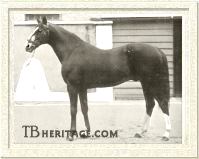
A photo of Gallinule

His sire, Isonomy
| |
His sire, Isonomy, was an extremely talented stayer and weight-carrier, placed in all but one of his fourteen starts, and winner, in his brilliant four year old year of the Ascot Gold Vase (2 miles), the Ascot Gold Cup (2- 1/2 miles), the Goodwood Cup (2-1/2 miles), the Brighton Cup (2 miles), the Great Ebor Handicap (2 miles) and the Doncaster Cup (2-5/8 miles). He was held in high regard by almost every top horseman--owner and trainer--in his time, honored for his courage and "grit."
After the death of his owner, two years after he retired to stud at Bonehill Paddocks, Tamworth, Isonomy was purchased by the Duchess of Montrose, and was relocated to her new Sefton Stud in 1884. His first truly successful youngster was Gallinule, a good juvenile, followed in 1885 by Oaks and St. Leger winner Seabreeze, English "Triple Crown" winner Common (1888), and his second Triple Crown winner, Isinglass (1890).
It was through Isinglass, whose son, Louviers, was so influential in Germany, and through Isinglass's grandson, that great progenitor, Swynford (1907, by John o' Gaunt), that the sire line descends to the present.
|
Gallinule's dam, Moorhen (1873), was by the influential sire and Derby winner, Hermit. Her dam was an unnamed daughter of Ascot Gold Cup winner Skirmisher; this mare was a sister to Ryshworth, who ran second in the Grand National Steeplechase at Aintree in 1873. Another brother, Ripponden, sired the black gelding Playfair, who won that great event in 1888. Moorhen's dam also produced Astwith (by Wenlock), second dam of some very good racehorses -- Llangibby, Hammerkop, Sirenia, and Dabchick -- the first by Gallinule's son, Wildfowler, and the latter three all by Gallinule, and so closely in-bred to this unnamed Skirmisher daughter.
Moorhen was bred by, and started her career on the turf in the colors of, the Duke of Devonshire, and won a selling plate for him at age three. She was then sold to Tom Green for 200 guineas; in all, she won six plates in her twenty four starts that season. At age four, she was bred to Vulcan, but continued to race on the flat (nine times) and over hurdles (five times) while pregnant. At the Doncaster sales that year she was purchased for 150 guineas by J.C. Hill of Lincolnshire. She dropped her foal to Vulcan, which never raced, and was rebred, but slipped that foal in the spring of 1879, and was put back into training until the age of nine, running on the flat in selling plate races, over fences, and in hunter flat races, and winning twenty times. Among her victories was a Hunt Cup Steeplechase at Birmingham. At age eight she was bred to Gladiateur, and the following year, 1882, dropped that foal, which did nothing of note on the turf. Barren for a year, she was taken to Isonomy in 1883, and the following year this versatile and durable mare dropped Gallinule. When she got to another high-class stallion, Galopin, in 1885, the resulting 1886 foal, the brown Pioneer, proved a good race horse, winning the St. James' Palace Stakes at Ascot. A daughter, foaled in 1887, named Silver Wing (by Silvester), was unsuccessful in her two starts at age two, but produced some daughters that bred on, and Moorhen produced two more foals, a black colt, Sheldrake, by Isonomy in 1888, who won some small races, and a foal by Galopin in 1889.
Gallinule was a handsome chestnut colt with two hind stockings, a front sock with a strip that ran from his knee to merge with it, and a bit of white along his coronary band on his other foot. He had a good-sized blaze and a peculiar hourglass-shaped splash of white on the left side of his face, that ran from below his eye to his nostril. He was well-boned, with excellent hocks and a powerful hind end; he topped out at 15.2 hands, the same height as his sire, Isonomy, when grown. By the time he was five, if not earlier, he had become a bleeder, breaking blood vessels in his nose during the exertion of racing, and, according to some accounts, a roarer as well.
He was purchased at the Newmarket yearling sales by E.H. Wood for 720 guineas, and made his first start in Wood's ownership. Wood placed him in training with William Walters, a former jump jockey who had won the Grand National Steeplechase of 1864 on the mare Emblem, and had spent several years as a private trainer for Sir Charles Rushout in Gloucestershire. Walters later trained two good stayers, Goldseeker, a long-shot winner of the City and Suburban in 1889, and Tyrant, schooled by Walters to win the Great Cheshire Handicap, the Great Northern Handicap, the Ascot Gold Vase and the Doncaster Cup, all in 1890.
Gallinule on the Turf
Gallinule failed to place in his first juvenile race, the Excelsior Breeders' Foal Stakes at Leicester in April, running in a group of undistinguished youngsters. Gallinule's owner, Wood, died shortly after the race, and Gallinule was sold for 800 guineas to George W.T. Brudenell-Bruce, Lord Savernake (later 4th Marquis of Ailesbury), who put him into the hands of trainer J.B. Tyler. Starting for the second time in July, Gallinule won the five furlong Queen Elizabeth Stakes, beating three others, and four days later ran second to the heavier-weighted Salisbury in the five furlong Zetland Plate, in a field of twelve. Three days later he won the National Breeders' Produce Stakes over five furlongs at Sandown by a good four lengths, beating Martley and Maxim and four others. He ran unplaced in the Champion Breeders' Foal Stakes, carrying 11 more pounds than the rest of the field. In August he won the Sandown Nursery Plate, beating a fairly good colt, MacLeod while giving him 14 pounds. In October he was beaten by a length by Marley, carring 114 pounds to his 126 pounds in a juvenile race at Kempton Park. He ran unplaced in his last race that season, the Chesterfield Nursery Handicap. He had shown himself to be a colt with some class in this first season.
He only ran three times at age three, unplaced in the Leicestershire Spring Handicap won by a six year old, Kinsky, and also unplaced in the Jubilee Stakes, beaten by Bendigo, Martley and Tyrone. His last race of the year was the Great Yorkshire Stakes at York August, where he ran second to Panzerschiff, at level weights, losing by three-quarters of a length. At that same meeting Ailesbury and his trainer, Tyler, were warned off the turf by the Jockey Club because Ailesbury had given his jockey, E. Martin, orders to stop his horse, Everitt, in a race following the Great Yorkshire Stakes, and probably because Ailesbury had been under suspicion for similar practices for a while...later turf texts often referred to "the unscrupulous Ailesbury."
In any case, the Marquis' horses were sold at Newmarket in October of 1887, and Gallinule was purchased for 5,100 guineas by a wealthy Scot, George A. Baird ("Mr. Abington" on the turf). Baird had won the Oaks and the 1,000 Guineas with the Petrarch daughter, Busybody in 1884, and earlier in 1887 had won the Derby with Merry Hampton. He was a notorious womanizer, an excellent amateur rider, a heavy drinker, heavy gambler, and one-time lover of the famous actress Lily Langtry, purchasing her an apology gift of a yacht -- The White Lady,referred to by "society" as "The Black Eye" -- after one of the many times he assaulted Lily in a rage.
Gallinule never won or placed in another race, for Baird, his newly-hired trainer Charles Morton (who replaced Martin Gurry, trainer of Merry Hampton at Bedford Lodge in Newmarket), or anyone else. Morton later said he realized Gallinule was a bleeder when preparing him for his first scheduled race for Baird. Gallinule started seven times at age four and ran unplaced in every race, and at age five, was unplaced in three starts. For the Lincolnshire Handicap, when Gallinule was five, Morton had tried Gallinule against a horse called Acme, who had been barely beaten in the Lincoln the year before, and Gallinule bested him by six lengths. His owner and his many gambling friends then considered Gallinule a sure bet for the race and backed him so heavily he became the favorite. But during the running, Gallinule bled, and his jockey, Sammy Loates, pulled him up and dismounted. By his next, and last, race, the Visitors Handicap at Newmarket July, Morton said Gallinule had turned into a roarer, and he instructed the jockey not to "knock the horse about" if he could not win, but "Gallinule himself decided the matter by breaking another blood vessel." Because the stable was secretive about just when Gallinule began to bleed, it is not clear how far back the problem went, and it possibly could have begun when under Ailesbury's ownership. Regardless, Gallinule was now a horse who had had promise as a juvenile, and whose racing merits could never be assessed, based on his subsequent record.
Gallinule in the Stud
Captain Henry (knighted in 1925) Greer had had Gallinule on offer as a stallion prospect, and purchased him in July of 1889 for £900 soon after Gallinule's disasterous last race. Greer was a neophyte on the turf, at least as far as ownership went, still a year away from his retirement from the Army, having served most of his time with the 74th Highlanders in India, where his recreational pursuits were cricket, rackets, golf and polo. The same year he bought Gallinule, Greer registered his colors of "White, tartan sleeves, and red cap."
Greer sent Gallinule to Brownstown Stud at the Curragh in Ireland, which he had purchased from the Knox family; Gallinule's great-great grandsire, Birdcatcher, had been born and stood as a stallion there. Greer was to become a respected and influential member of the Jockey Club and the Irish Turf Club, and a highly successful breeder of racehorses. He was appointed the first director of the National Stud after its birth in December, 1915, and remained as its head until 1933. He sold Brownstone Stud in 1917, the year both his sons, serving in the Irish Guards, were killed in World War I. He later assumed the management of the Aga Khan's six farms that comprised his Irish stud, Sheshoon.
Gallinule began his first season in 1891. As a known bleeder, patronage was initially scant, despite the low 25 guineas fee charged for his services, but Greer supported him himself, forming a "pool" with his trainer, Sam Darling, of good mares, the most notable being the Irish Derby winner Tragedy, which Greer bought just before purchasing Gallinule; she later produced St. Leger winner WILDFOWLER (1895), Gallinule's first classic winner.
His first offspring to reach the track were eight two year olds of 1893, seven of which won, six of them in Ireland. His patronage improved, and by 1897 it was clear he was enroute to becoming an influential stallion--the next year he was among Great Britain's leading sires, with twelve sons and ten daughters winning a total of £18,356. By then, he had sired two Irish Derby winners -- PORTARNOCK (1892) and the half-bred GULSALBERK (1893); he was to sire four more winners of that race in succession: NOBLE HOWARD (1895), OPPRESSOR (1896), GALLINARIA (a filly, 1897), and CARRIGAVALLA (1898). A daughter, DABCHICK (1894), won the Irish Oaks during that period.
In 1904, with offspring earnings of £30,925 (PRETTY POLLY accounted for £19,040 of it), he topped the leading sires list, and was second in 1903, 1905 (he would have been first had his Irish winners been included in the list), and 1907, and third in 1909. Greer gradually raised Gallinule's fee to 200 guineas, where it stayed, despite his success as a sire. Of his over 200 foals, nine were known bleeders; among his 36 top winners, two, LESTERLIN, who won six races, and SANTRY, who won seven, were prone to bleeding.
He sired four English classic winners: WILDFOWLER (1895, St. Leger), SLIEVE GALLION (1904, 2,000 Guineas), NIGHT HAWK (1910, St. Leger), and the great mare PRETTY POLLY (1,000 Guineas, Oaks, St. Leger). Despite siring three St. Leger winners, and a few great stayers, notably daughters PRETTY POLLY and HAMMERKOP, and son OPPRESSOR, his offspring were mostly good middle-distance horses, and a few, such as son COCK-A-HOOP, were sprinters. He also got two classic winners in Germany: HAMMURABI, and WALDKATZE. He was a noted sire of good juveniles: of his 197 winners between 1893 and 1911, 111 of them won as two year olds. A number of his sons were sold abroad, and those that stayed in Britain were unable to get good sire sons. He was, however, a highly successful broodmare sire, leading the list five times, in 1908, and posthumously in 1911 (Willonyx's brilliant year), 1913, 1918, and 1920 (Spion Kop's Derby year).
Gallinule is also seen in the pedigrees of some top jumpers, a talent he probably passed on from both his grandsire, Sterling, and his long-running jumping dam, Moorhen. His son, TRAVELLING LAD (1896) sired the 1915 Grand National Steeplechase winner Ally Sloper (1909). Gallinule's unraced son GOLDMINER (1904) got Goldcourt, who became a top jumper sire, getting two Irish Grand National winners and the great Irish steeplechaser Golden Miller (1927), who won both the Cheltenham Gold Cup and the Grand National in the same year. Gallinule's son GENERAL PEACE (1905), who won the Paris Hurdle Race, got the 1908 Irish Oaks winner Queen of Peace, and was grandsire of an Irish Grand National winner and great-grandsire of Grand National winner Gregelach (1922). Irish Derby winner OPPRESSOR, a brother to General Peace, sired 1912 Irish Oaks winner Shining Way and Kellsboro Lass, the dam of Grand National winner Kellsboro Jack (1926), and another son, ZADKIEL, had a daughter, The Nun, who won point-to-points and later produced Grand National winner Lovely Cottage (1937). Gallinule's son WHITE EAGLE (1905), sired American Grand National winner Erne II. Gallinule's son SLIEVE GALLION became a sire of many champion steeplechasers in Hungary. Caughoo (1939) and Bogskar (1933), both Grand National winners, were great-great grandsons of Gallinule.
Gallinule developed a paralysis of his lower bowel, and towards the end of his life had to have his droppings removed by hand. Though otherwise in good health, he was destroyed at Brownstone at age 27 on January 9, 1912.
|
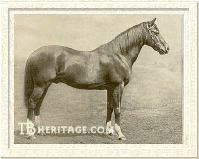
Wildfowler

Slieve Gallion

Hammurabi

Chilperic
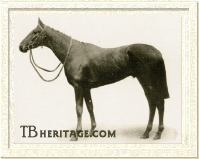
Night Hawk

Phaleron
| |
WILDFOWLER (1895) was out of the Irish-bred Ben Battle filly, Tragedy, who had won the Irish Derby in 1889. Tragedy, along with two other mares were put in a "pool" with two horses purchased by Greer's trainer, Sam Darling, the resulting foals being owned by the Greer-Darling partnership. Wildfowler, winner of four of his eight races at ages 2 and 3, was somewhat backwards, running fourth in the Guineas, and did not race in the Derby, but he decisively won the St. Leger, beating the Derby winner Jeddah, and thus becoming the first Irish-bred winner of that race since the 1840s.
Greer bought out Darling and put WILDFOWLER in the stud, where he was moderately successful, getting Eclipse Stakes winner and later sire, Llangibby, and Irish Derby winner Wild Bouquet (1905). His daughter, Silver Fowl later became dam of the dual classic winning filly Fifinella, and of Cambridgeshire winner Silver Tag, and another daughter, Blue Tit, a minor winner herself, produced the influential broodmare Teresina. In 1908 WILDFOWLER was sold to a French Syndicate for £5,000, and eight years later, age 21, was sold in Paris for £15.
SLIEVE GALLION (1904) was bred and owned by Greer. He was out of the St. Florian daughter Reclusion, a fast Irish filly who had won two of her five races at age two. Under the Beckhampton trainer Sam Darling, SLIEVE GALLION became a good juvenile, winning the New Stakes at Ascot, the Champagne Stakes at Doncaster, and placing second in the Middle Park Plate. He easily won the Craven Stakes and the 2,000 Guineas at age three, ran third to Orby in the Derby, and then won the St. James's Palace Stakes at Ascot, after which he was sold to Hungarian sportsman Mikos de Szemere; soon thereafter he broke down and was retired. In all, he had won £11,995.
Sold to the Hungarian National Stud at Kisber, SLIEVE GALLION sired some good juveniles that rarely trained on. However, he was an excellent sire of jumpers, getting a number of Hungarian national champion steeplechasers. One son, Onkel Ludwig, was sold to stud in Germany, and another, Palatin, was sold as a stallion to Poland. SLIEVE GALLION was destroyed at Kisbér Stud after twenty years there, in the summer of 1926.
HAMMURABI (1903, out of Coronation Stakes and Yorkshire Oaks winner Helm (a half-sister to Frontier and Grey Leg), by Morion), was a classic winner in Germany. Owned by the German state stud at Graditz, he won the Deutsches St. Leger, and placed second to Ignis in the Hertefeld-Rennen and to Derby Cup in the Fürstenberg Rennen at age three, and at four took the Großer Preis von Baden, Köln's Preis von Donaueschingen, and the Hoppegarten's Wilamowitz-Zucht Rennen. He served as a stallion at the Union-Gestüt at the Hoppegarten and elsewhere, where he was at best moderately successful, nowhere near the quality of SLIEVE GALLION in Hungary. One half-bred son, Meridian (1919) became a stallion in the depot at Gudwallen, where he got some East Prussian half-bred youngsters. His daughter, Eidechse (1910, out of Eccola, by Saraband) was a useful juvenile runner and later dam of Enak (1929), a long-running sprinter/miler that won the Badener Meile at Baden-Baden twice, the Espoir-Ausgleich at Hamburg twice, and several other good races.
CHILPERIC (1908, out of Chilmark), was another classic winner in Germany. His pregnant mother was purchased in England by Austo-Hungarian sportsman Baron Gustav Springer (also owner of Deutches Derby winners Palmyra, Gailfard, and Bono Modo). CHILPERIC won the Deutches Derby in 1911, beating eleven, although the best of the year had been sidelined by the dreaded "Hoppegartner Cough." He won a total of six races in twenty starts over four seasons, with five placings, in Germany and Austria-Hungary.
|
NIGHT HAWK (1910) was Gallinule's third and last St. Leger winner. Like WHITE EAGLE, he was bred by Colonel Hall Walker, out of the Ayrshire daughter Jean's Folly (1901). Jean's Folly traced back in tail-female to the Sterling Daughter Black Corrie, which made NIGHT HAWK in-bred 3 x 5 to Sterling. The bay colt did not start at age two, and at age three started inauspiciously in the mile Hurst Plate at Hurst Park, running fourth. He went on to meet Aghdoe, conceding 24 pounds, at Liverpool, and ran two lengths behind him for second place. Sent to trainer W.T. Robinson at Foxhill, in August he ran second to Birlingham at level weights at Hurst Park, and that was followed by a third, by three lengths, to Roseworthy and Louvois, over a mile and 3 furlongs at Derby. He entered the St. Leger at odds of 100 to 1 in a middling field where many of the best three year olds had been sold abroad or had broken down. NIGHT HAWK won the St. Leger by two lengths, beating a pretty good horse in White Magic and a field of ten other horses; this was the only win of his career. He was subsequently sold to Australia as a stallion, where he had little impact.
PHALERON (1906) was bred by William Cavendish-Bentinck, 6th Duke of Portland, from his tiny good mare, Oaks winner Mrs. Butterwick (by St. Simon). A small, long chestnut colt with the characteristic Gallinule white markings, he was a fairly good juvenile. At three he improved, winning a number of races, including the Royal Stakes and the Jockey Club Stakes at Newmarket, and running second to Minoru in the 2,000 Guineas, beating Louviers and Bayardo. At age four he discovered he could unseat his jockeys with a few well-timed bucks, dumping them at Epsom and at Salisbury, and then skipping back to the paddock to eat grass, waiting to be caught; consequently, he only won one race that year, a walk over at Newmarket. At age five won a race at Kempton. He was one of Gallinule's bigger winners, with earnings of £10,376. His influence in the stud was minimal, but he did get the highly influential mare Pearl Maiden (1918, from Seashell by Orme), who bred ten winners in various countries, including three classic winners -- the great French racemare Pearl Cap (1928, French Oaks, French 1,000 Guineas, Prix de l'Arc de Triomphe, and dam of Derby winner Pearl Diver); Pearlweed (1932, Prix du Jockey Club); and Biperl (French 1,000 Guineas). |

White Eagle
| |
WHITE EAGLE was a handsome chestnut bred by Colonel Hall Walker (later Lord Wavertree) at his Tully Stud in Ireland in 1905. His dam, the Galopin daughter Merry Gal, was a good winner and stayer. She was out of an Isonomy daughter, Mary Seaton, making White Eagle in-bred 2 x 3 to Isonomy. Although not a classic winner, he won some good races in his three seasons on the turf, with winnings of £15,823. He was a precocious juvenile, winning the Woodcote Stakes by five lengths, and three other races in his five starts, including the National Breeders' Produce Stakes at Sandown, beating the future Oaks and Derby winner Signorinetta and the future 1,000 Guineas winner Rhodora. |
At age three he ran unplaced in the Derby, finished third in the 2,000 Guineas, and was second to Your Majesty in the St. Leger, the longer distances proving to suit him best. His five wins at age three included Newbury's Royal Stakes, beating Signorinetta again, and a Biennial at Ascot, in which he beat Rhodora again. In his final season he won the City and Suburban handicap, the Atlantic Stakes, beating Your Majesty, and ran second in the Coronation Cup.
WHITE EAGLE did not live up to his pedigree or his race record at stud. He was one of the horses Walker gave to the National Stud during World War I, and while like other stallions, his opportunities were limited during the war, afterwards he continued to disappoint. He was more successful as a sire of precocious juveniles and of good producing daughters than anything else; one of his best was Let Fly, a top two year old that won the Ascot's New Stakes and the Dewhurst Stakes and was second to his principal opposition, Redfern, in the Molecomb Stakes and Doncaster's Champagne Stakes. At age three Let Fly ran second to Pommern in the wartime Derby, and also won the Champion Stakes, due to the disqualification of Silver Tag. Let Fly was sent to stud in Argentina.
In all, WHITE EAGLE got winners of 228 races at £70,938. Other good winners were the filly White Bud (Lincolnshire Handicap) and Eagle's Pride (Cesarewitch Stakes Handicap). As a broodmare sire he gained a place in the pedigree books through his daughters: Blanche, dam of the influential sire Blandford, and of Silver Hussar; Royal Favour, dam of St. Leger winner Royal Lancer; Lady Peregrine, dam of 2,000 Guineas winner Flamingo: Dolabella, dam of champion juvenile filly and brilliant sprinter Myrobella, later dam of Big Game; the minor winner Quick Thought, dam of Cosquilla, a winner of seven races in France and dam of influential sire Princequillo. At age 23, a growth on WHITE EAGLE'S leg was causing him a deal of pain, and he was euthanized at the National Stud in October of 1928.
Gallinule's other sons included FARIMAN, a juvenile stakes winner in Ireland, winner of six races and £5,299, who got some good daughters, including Vaila, a stakes winner at age two, who was purchased to America where she became second dam of the influential sire, Blue Larkspur, and Feronia, dam of Irish Derby winner He Goes (1917, by Prince Palatine). The aforementioned bleeders, LESTERLIN (1892) and SANTRY (1901) won, respectively, six races and £4,033, and seven races worth £4,562. Both became sires.
Gallinule's Daughters
Gallinule sired one of the best race mares of all time, Pretty Polly, and some other high class fillies. His daughters were excellent producers, some getting good sprinters, some top middle distance horses, and many high class stayers and weight carriers. He was leading broodmare sire in England in 1908, 1911, 1913, 1918, and 1920, and was second on the list several times. Two daughters produced English classic winners -- Countess Zia (1910), dam of 2,000 guineas winner The Panther, and Hammerkop, dam of Derby winner Spion Kop (1917). As sire of Palotta (1893), he was damsire of Americus Girl and Lady Americus, and as such is present in the pedigrees of many major modern winners through Fair Trial, Abernant, Tudor Minstrel, Nasrullah, Royal Charger and many others.
|
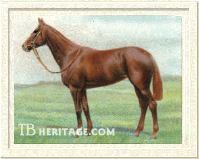
Pretty Polly
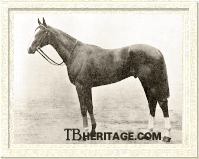
Pretty Polly's brother Admiral Hawke
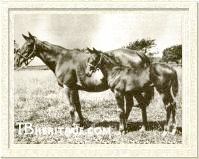
Alope with Aloe at Foot
| |
PRETTY POLLY (1901), was out of the modest race mare, Admiration, who ran through age five in England and Ireland, winning once twice, over six furlongs in a handicap at Leopardstown and in a handicap at Baldyle over one mile, and placing second four times, once in England. Pretty Polly, unbeaten at age two in nine starts, became one of the top racemares and stayers of all time, winning twenty four of her twenty six starts, including the 1,000 Guineas, the Epsom Oaks, the St. Leger, the 2 mile-2 furlong Jockey Club Cup, the Ascot Gold Cup, and many more top events. None of her foals were particularly successful on the turf, but a number of classic winners descended from her daughters.
PRETTY POLLY'S brother, ADMIRAL HAWKE (1907) was a good juvenile winner of five races in seven starts -- Ascot's Coventry Stakes (by three lengths, beating seventeen), Newmarket July's Fulbourne Stakes (by a head), Goodwood's Lavant Stakes, Newmarket's Criterion Stakes and the Moulton Stakes, placing second to Neil Gow in Doncaster's Champagne Stakes, with Lemberg third. At three unlike his sister, he demonstrated he was not a stayer: he won Newmarket's Midsummer Stakes and the Ascot Triennial, and was second in the Sussex Stakes and the Ascot Derby, but the Two Thousand Guineas (placed sixth), Epsom Derby (placed fifth), and 1-1/2 mile Princess of Wales's Stakes (unplaced) were too far for him. He was sold to Germany as a stallion, but was not very sucessful; he is seen in the pedigrees of some German classic winners through his daughters.
ALOPE (1909, out of Alotviscar, also dam of the producers Only Girl and Commedienne) was a pretty good race filly for her owner Baron G. Stringer, winning four races at age two, including the Moulton Stakes and the Ashley Plate at Newmarket, and running third in two other races of her nine starts that season. At age three she did not win, but placed in some top class races, including the 1,000 Guineas and Epsom's Stewards' Handicap, where she was beaten by a neck.
At first ALOPE was an unreliable producer, barren in five of her first eight seasons at stud. Sold in 1919 to Donald Fraser of Tickford Park Stud, in 1920 she produced Alopex, later gelded, who won some middle distance handicaps.
|
In 1922 ALOPE dropped Foxlaw, by Son-in-Law, and was sold with Foxlaw at foot to South African Sir Abe Bailey. Foxlaw became a great stayer, ultimately winning the Ascot Gold Cup at age five, and although breaking his leg at age 13 and dying young, he sired two Ascot Gold Cup winners, Foxhunter and Tiberius, and Goodwood Cup winners Cecil and Fearless Fox, as well as Foxbridge who was the leading sire in New Zealand for 11 consecutive years. In 1926 ALOPE dropped Foxlaw's sister, Aloe, who was sold at age two at Newmarket Houghton sales to Lord St. Davids, for whom she ran second to Oaks winner Pennycomequick in the Haverhill Stakes, second in the Nassau Stakes, and several other placings in good races. Aloe was a good producer and dam of good producers who spread the influence of this female family around the world. ALOPE was destroyed in 1933.
Some of Gallinule's other good daughters included:
PALOTTA (1893), whose name will ever be present in a multitude of pedigrees of top horses through her daughters Americus Girl and Lady Americus, was bred by Edward Smithwick in Ireland. Although she ran for four years, she won just three minor races, a £300 plate at Down Royal, and the Drogheda Memorial at the Curragh over five furlongs, and the Lord Lieutenant's Handicap (worth £132) over seven furlongs. She was out of the unraced Maid of Kilcreene, by Arbitrator. At the end of her career Palotta was purchased by J.C. Blake, and sold soon thereafter to A.H. Ledlie, who sent her to Greenfields Stud to be bred to the Galopin son, Buckingham, producing three foals, two of which were minor winners. Bred to Islington, a brother to Isinglass (by Isonomy), she produced Palladia, a winner over fences. She reached Americus, standing at Richard "Boss" Croker's stud near Dublin, in 1904, and in 1905 dropped Americus Girl, a top sprinter who won 12 races worth £8,371, who bred Lady Josephine (by Sundridge), and Lady Colin (by Colin) at Ledlie's Belvoir Stud in Ireland. Lady Josephine, sold at the Doncaster sales to Henry Savill, won four of her five races as a juvenile, and, after failing to win at three, was sold as a broodmare to Sir Mark Sykes, owner of the famous Sledmere Stud. There she produced Mumtaz Mahal, "the flying filly," ancestress of Mahmoud, Nasrullah, Royal Charger, et. al., and the stakes winning stayer Lady Juror, dam of Fair Trial and ancestress of Tudor Minstrel, Abernant, and other influential horses. Lady Americus, a two-time winner, was ancestress of some good stakes winners. |
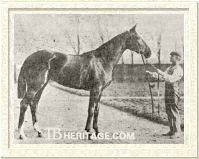
Game Chick
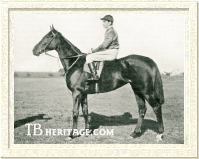
Hammerkop, a great race mare and dam of a classic winner

Her sister, Sirenia, unbeaten and dam of two classic winners
| |
GAME CHICK (1899) was out of the great stayer Barcaldine's daughter, Tierce (1891). GAME CHICK was a very good juvenile, winner of Doncaster's Champagne Stakes, the National Breeders Produce Plate at Kempton, and the Dewhurst Plate at Newmarket. She lost form at age three, winning the September Stakes by a neck, and running second in the Duchess of York Plate at York, and a very bad third of three runners in the Yorkshire Oaks. In all, she won seven races for a total of £9,789 in winnings.
Irish-bred HAMMERKOP (1900), from the non-winning Concussion, by Reverberation, was another great staying daughter of Gallinule bred by Eustace Loder at his Eyrefield Lodge. Between 1902 and 1909 and 51 starts she won, among other races, the July Stakes at Newmarket, two Alexandra Plates at Ascot, the Yorkshire Oaks (and second in Epsom's Oaks Stakes), the Great Yorkshire Handicap, and the Cesarewitch, in all her winnings totalled £10,793. After age seven, she failed to win, and many thought her career unnecessarily extended. In the stud HAMMERKOP produced just one winner, Spion Kop, by Spearmint, winner of the 1920 Derby and the minor Spelthorne Stakes, and nothing else; he later sired Derby winner Felstead, Irish Derby winner Kopi, who later was a successful sire in France, and The Bastard (later renamed The Buzzard), who became an influential sire in Australia.
Concussion also produced SIRENIA (1895) and DABCHICK (1894) to the cover of Gallinule. DABCHICK won the Irish Oaks and at age four was stakes-placed over fences; she was sent to stud in Germany. SIRENIA was an unbeaten juvenile in Ireland, whose wins included the Anglesey Stakes and the National Produce Stakes. In England she won Kempton's Duke of York Stakes, the Lancashire Handicap at Manchester and Kempton's Great Jubilee Handicap and October Plate. Her nine races netted her £7,736 in winnings. She bred seven winners, including 2,000 Guineas winner Tournament (by Spearmint), 1,000 Guineas winner Electra (1906, by Eager and so in-bred to Sterling), and Siberia (1905, by St. Simon), winner of the Yorkshire Oaks, Park Hill Stakes, Goodwood's Nassau Stakes and later dam of Epsom Oaks winner Snow Marten. |
Gallinule's daughter TRIBONYX (1902) was out of Fervour, who was by the Cesarewitch winner Chippendale. TRIBONYX was bred by Greer, and bought as a yearling by P.P. Gilpin, who sold her to A.W. Davis. She ran unplaced three times at age two and was sold to J. Musker, who sent her to Newmarket December sales in 1904. Purchased for 45 guineas by E. Bird, she was sent back to auction at Newmarket's July sales, in foal to St. Maclou. Trainer John Porter picked her up for 100 guineas. She slipped twins to St. Maclou and Porter bred her back to William the Third; in 1907 she dropped Willonyx, who won ten of his twenty races and was out of the money only twice in his career. Willonyx was a great stayer and weight carrier -- trained by Sam Darling and owned by C.E. Howard -- whose wins included the Chester Cup, the Ascot Stakes, the Ascot Gold Cup, the Jockey Club Gold Cup and the Cesarewitch, all in one year, 1911. He was a disappointment at stud, but did get Cesarewitch winner Air Raid, who became a good sire in Uruguay and Argentina. TRIBONYX, bred to Littleton after she produced Willonyx, was sold to Edmond Blanc for £1,000, and shipped to France. There she bred Good Luck, by Blanc's homebred stallion Ajax, who was purchased by J.D. Cohn and ran in Spain, where he won the top juvenile race, the Criterium de Saint-Sebastian.
|

Waldkatze
| |
GALLENZA (1905) was unraced, but in M. Varipati's stud she produced seven winners. She was out of Excellenza (1897), and so in-bred to Gallinule's great-grandsire, Oxford; Excellenza was also dam of the brothers Ambassador IV and Brown Prince, both sires in America. GALLENZA produced Perce-Neige (1916, by Neil Gow), a modest winner who became dam of Oaks winner Rose of England (1927, by Teddy). GALLENZA was also the dam of the good handicapper Winalot (1921, by Son-in-Law), a successful sire in Ireland.
WALDKATZE (1905) was out of Water Lily (1898, by Ocean Wave), imported into Germany while pregnant, and dropping WALDKATZE at the state stud at Graditz the next year. WALDKATZE won the Preis der Diana, with five runners, and in the fall placed second (of two) to Horizon in Frankfurt's Wäldchens-Rennen. She did not breed on.
|
PRINCESSE DE GALLES (1906), was out of a Persimmon daughter, Ecila (1899). She was another good juvenile, winner of four of her six races in that season, including Goodwood's Ham Stakes and Newmarket's Chesterfield Stakes, and ran second in her other starts that year, the Prince of Wales's Stakes and Doncaster's Champagne Stakes. At age three she ran second to her close relative, Electra, in the 1,000 Guineas, and second again, this time to Perola, in the Epsom Oaks, and won the Coronation Stakes at Ascot. Her winnings for her five wins were £6,110. She produced Sir Dighton, a modest runner who did nothing much in the stud in Australia; however, a daughter, Etoile, remedied that eventually, as second dam in tail-female of Stardust (1937, by Hyperion), who sired the preeminent Australian stallion Star Kingdom.
GALLORETTE (1907), out of the Bend Or daughter, Orlet, produced Prince Chimay (1915) to the cover of Chaucer. He won the substitute Ascot Derby in 1918 (Windsor Stakes at Newmarket) and the Jockey Club Stakes, in which unexpectedly he beat Gainsborough, and two other races. First at stud in England, he was sold to France, where he sired the influential stallion Vatout (1926), winner of the French 2,000 Guineas.
COUNTESS ZIA (1910), from the Collar daughter, Order of Merit, placed once in two seasons in the turf. In the stud she produced The Panther (1916, by Tracery), a good juvenile who won two races at Newmarket and was ranked first in the free handicap for his generation. At age three he won the 2,000 Guineas (beating Buchan), and then decided to quit running -- "...he had acquired a rooted dislike for racing, just as his dam did." He was sold to Haras Las Ortigas in Argentina as a stallion, where he got winners of 319 races, the best of them the unbeaten Capablanca. His successes and breeding prompted a syndicate to repurchase him for England, and he was shipped back in 1929, but most of the mares he covered after arriving failed to conceive; he died in 1931. COUNTESS ZIA also produced Bhuidhaonach (1919), who won the Manchester Cup.
MONISIMA (1910) was out of a good-producing Persimmon daughter, Mesange. Although Monisima did not place in any of her races, she became the dam of Spearwort (1917, by Spearmint) winner of the Ascot Stakes and Queen Alexandra Stakes. Monisimia's daughter, Messaline (1923, by Caligula), was a non-winner who was shipped to the U.S. to breed to Man o'War and sent back to England to foal out Roman Gallery (1931) who became the dam of the long-running handicapper (who also won steeplechases and hurdling events), Arctic Slave (1950), a good sire of steeplechasers and a good broodmare sire.
--Patricia Erigero
|
|
|
|

